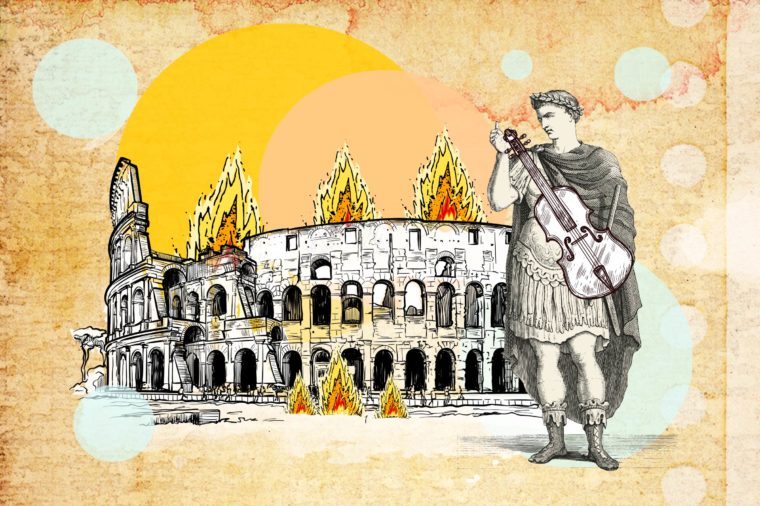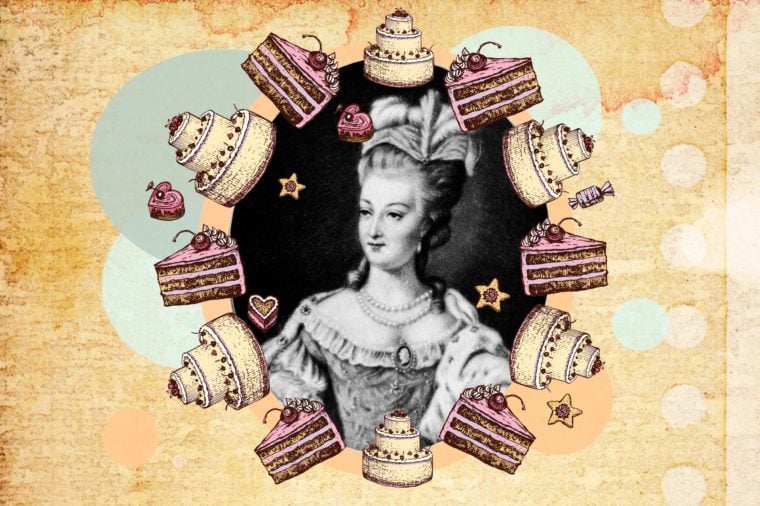9 Famous Moments in History That Never Actually Happened BY MEGHAN JONES ( courtecy;- reader's digest )
- লিঙ্ক পান
- X
- ইমেল
- অন্যান্য অ্যাপ
You've probably accepted these nine occurrences as historical fact—but they're actually totally false, or at least highly embellished.
Nero didn't fiddle while Rome burned
 TATIANA AYAZO/RD.COM
TATIANA AYAZO/RD.COM
Ah, Nero, the original unconcerned bystander. While this first-century Roman emperor certainly isn't blameless in the story of Rome's fiery fall, he definitely wasn't playing the fiddle during it. For one thing, Nero wasn't even in the city when the fire began; he was in Antium, about thirty miles outside of the city. For another...there was no such thing as a fiddle in ancient Rome. While Nero was a musician (and supposedly liked to play a harp-like instrument called the cithara), he sure wasn't playing an instrument that wouldn't appear until the 11th century. A Roman historian has claimed that, if anything, he was singing about the legendary fall of Troy when he learned his city was burning, but there were no witness accounts to back this up. Here are some more history facts your teacher lied to you about.
Rats didn't actually spread the Black Death
 TATIANA AYAZO/RD.COM
TATIANA AYAZO/RD.COM
Recent studies have discovered that rats may not actually be to blame for this devastating plague that wiped out a third of 14th century Europe. So it's time to rat out the real culprit. Scientists at the University of Oslo conducted an experiment that assessed the potential transmission routes for the deadly pandemic. They discovered that the parasites that carried the disease were much more likely to have come from humans than rats. The model showing the disease spread by human fleas and lice matched the death rates of the actual Black Death much more closely than the model involving parasite-carrying rats. Sorry for pinning the blame on you for all these years, little guys.
The Niña, the Pinta, and the Santa Maria weren't the names of Christopher Columbus's ships
 TATIANA AYAZO/RD.COM
TATIANA AYAZO/RD.COM
When it comes to Columbus, the only fact that the history books really have right is that he sailed in 1492. First of all, he didn't "discover" America—people had already been living on the continent for thousands of years, after all. And he wasn't even the first European explorer to reach North America; a crew of Vikings actually sailed to Canada around 1000 AD. Even the oft-repeated names of his three ships aren't historically accurate. In the 15th century, most sailing ships were named after saints, so while the Santa Maria is probably the real name, the Niña and the Pinta were probably just casual sailor nicknames for more piously named vessels. According to history.com, the Niña's real name was most likely "the Santa Clara," while the Pinta's real name is unknown. Here are some more history and science facts you've always believed that are totally untrue.
Martin Luther (probably) didn't dramatically nail his 95 Theses to a church door
 TATIANA AYAZO/RD.COM
TATIANA AYAZO/RD.COM
The revolutionary monk Martin Luther and his list of grievances about the Catholic Church have gone down in history as the catalyst for the Protestant Reformation. While the 95 Theses were real, and did have a major impact on people's perceptions of the Catholic Church, the events didn't quite go down the way you learned. There is no historical evidence that Luther posted the theses on the church door; that story wouldn't appear until 30 years after 1517, the year the act was supposed to have taken place. What we do know for certain is that he very politely mailed his 95 Theses to the archbishop, and that he never actually intended to start a revolution within the church. Luther was a devoted Catholic, and he simply wanted the clergy to recognize their corruption. Even if he did also post the theses on the church door, that wasn’t quite the defiant act historians have portrayed it as. It was actually the norm, since that's where the church notice board was located.
An apple never fell on Isaac Newton's head
 TATIANA AYAZO/RD.COM
TATIANA AYAZO/RD.COM
The story that the famous mathematician had an epiphany about gravity after being bonked on the head by a piece of fruit is most likely an embellishment of what really happened. The first time the apple story appeared was in a biography of Newton written by his friend William Stukeley in 1792. The account says, "the notion of gravitation came into his mind…. occasion’d by the fall of an apple, as he sat in a contemplative mood." Historians believe that he may well have seen an apple fall and begun pondering why it did so; but nowhere in any records of Newton's life does it say it hit him on the head. Learn some historical events you won't believe happened at the same time as one another.
Suspected witches weren't burned at the stake in Salem
 TATIANA AYAZO/RD.COM
TATIANA AYAZO/RD.COM
Nope. Even though you probably think of "Salem witch trials" and "witch burnings" as interchangeable, not a single accused witch in 17th century Salem suffered a fiery fate. All but one of the 20 people executed for practicing witchcraft in the colonial Massachusetts town were hanged, while the twentieth victim was crushed to death with heavy rocks. While a few other accused sorcerers died in prison awaiting trial, there were no burnings—at least not in Salem. The widespread idea that witches were burned most likely stems from witch hysteria that took place in Europe. In the 15th to 18th centuries primarily, anti-witch hysteria did rage throughout western Europe and Scandinavia, and many of those accused witches were burned at the stake.
Ben Franklin didn't discover electricity
 TATIANA AYAZO/RD.COM
TATIANA AYAZO/RD.COM
Ben Franklin's famed experiment involving a key tied to a kite wasn't quite the revolutionary scientific venture you might think it was. He certainly didn't "discover" electricity; scientists already were well aware of its existence in 1752, the year of Franklin's experiment. What Franklin sought to discover was whether lightning was a form of electricity, and he was the first to propose that hypothesis. But, complicating matters, it may not even have been Franklin himself who sent the famous kite into the air. In 1752, Franklin wrote in the Pennsylvania Gazette about the success of the experiment and described how it worked—but he never actually said that he performed it himself. It wasn't until 15 years later that scientist Joseph Priestly wrote an account attributing the experiment to Franklin.
Marie Antoinette didn't say "Let them eat cake"
 TATIANA AYAZO/RD.COM
TATIANA AYAZO/RD.COM
The doomed French queen never actually made this condescending remark about her impoverished subjects. There are accounts of spoiled royals suggesting that poor people eat delicacies they can't afford dating back long before Antoinette's rule. In one such tale, a German noblewoman suggests that her subjects eat a sweet bread called Krosem—in the 16th century (Antoinette was born in the 18th). The "Let them eat cake" quote itself—"Qu’ils mangent de la brioche" in French—first appeared in a 1767 autobiographical account by the philosopher Jean-Jacques Rousseau. He attributes the quote simply to "a great princess." Considering that Marie Antoinette was a young girl at the time, it almost definitely wasn't her. Here are some more famous quotes that constantly get misattributed.
Vincent van Gogh didn't cut off his ear
 TATIANA AYAZO/RD.COM
TATIANA AYAZO/RD.COM
Not all of it, anyway. The artist only severed the bottom part of his left ear, and no one knows for sure the reason he did it. He was certainly suffering from severe depression at the time. Some historians claim that he was agitated after a spat with his artist frenemy Paul Gaugin. Others claim that it was an act of rage committed after he learned that his brother, who was a major source of financial and emotional support for him, was engaged. One thing is for sure, though: it definitely wasn't his entire ear. Think you're a history expert? See if you know the answers to these history questions everyone gets wrong.
- লিঙ্ক পান
- X
- ইমেল
- অন্যান্য অ্যাপ
মন্তব্যসমূহ
একটি মন্তব্য পোস্ট করুন